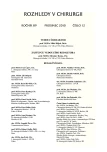Rare Umbilical Anomalies
Authors:
J. Kysučan; T. Malý; Neoral. Č.
Authors‘ workplace:
I. chirurgická klinika FN Olomouc, přednosta: doc. MUDr. Čestmír Neoral, CSc.
Published in:
Rozhl. Chir., 2010, roč. 89, č. 12, s. 764-769.
Category:
Monothematic special - Original
Overview
Introduction:
Umbilicus is a scar, which is the place of the previous merger of the fetus with the umbilical cord. After birth, it has no known function, however, unless the umbilical annulus is completely closed, umbilical hernia may occur. Umbilical scar is also an area where may occur a number of anomalies that may be present alone or together with umbilical hernia. Failure of involution leads to persistence of omphalomesenteric duct and urachal remnants. These embryonic remnants may cause more or less significant clinical problems, or may be completely asymptomatic and may be diagnosed at random.
Materials and methods:
The authors present their own group of patients who were diagnosed and dealt with the defect omphalomesenteric duct or urachus. In past 7 years we observed 35 children with these abnormalities. A large group of patients represents incidental findings during elective surgery for umbilical hernia. Another large group are patients with symptomatic or asymptomatic Meckel’s diverticulum. The anatomical observations, clinical manifestations, complications and treatment of these anomalies are mentioned.
Results:
A total of 35 children were found with these birth defects. In 23 cases we observed omphalomesenteric duct disorders and 12 urachal remnants were reported. Of these, 12 abnormalities were found incidentally during elative procedure for umbilical hernia. Asymptomatic or symptomatic Meckel’s diverticulum appeared in 16 cases. Surgical treatment included resection or exstirpation, if urachal anomaly was accompanied then partial resection of the bladder vertex was added. Postoperative complications emerged in 4 cases, three times it was ileus from adhesions 6 months after surgery, once postoperative cystitis appeared and was treated conservatively.
Conclusion:
Birth abnormalities of the umbilicus are relatively rare diseases that may occur in the pediatric population. Omfalomesenteric duct and urachal anomalies constitute a major group of these congenital disorders and are often associated with umbilical hernia. They can be diagnosed soon after birth or later in life. Surgical treatment involves excision or radical exstirpation to prevent early or late complications (urachal carcinoma in adulthood).
Sources
1. Giacalone, G., Vanrykel, J.-P., Belva, F., Aelvoet, C., De Weer, F., van Dodere, S. Surgical Treatment of Patent Omphalomesenteric Duct Presenting as Faecal Umbilical Discharge. Acta chir. belg., 2004, 104, 211–213.
2. Cilley, R. E. Disorders of the Umbilicus. In: Grosfeld, J. L., O’Neill, J. A., et al.: Pediatric Surgery. 6th Edition, Volume 1, Mosby, 2006, 1143–1155.
3. Cullen, T. S. Embryology, Anatomy, And Diseases of the Umbilicus Together With Diseases of the Urachus. Philadelphia, WB Saunders, 1916.
4. Gray, S. W., Skandalakis, J. E. The Bladder and Urethra. In: Gray, S. W., Skandalakis, J. E. (eds.): Embryology for Surgeons: The Embryological Basis for the Treatment of Congenital Defects. Philadelphia, WB Saunders, 1972, 519–552.
5. Steinthal, A. J. Malformations of the Umbilicus And Urachus: Faultry Closure of the Vitello-Intestinal Duct And Its Results In: von Bergmann, E., von Bruns, P., von Mikuliez, J., et al (eds.): A System of Practical Surgery. Philadelphia, Lea Brothers, 1904, 142–149, 593–606.
6. Palazzi, D. L., et al. Care of the umbilicus and management of umbilical disorders. http://www.uptodate.com/home/index.html. Accessed Oct. 15, 2009.
7. Ueno, T., Hashimoto, H., Yokoyama, H., Ito, M., Kouda, K., Kanamaru, H. Urachal anomalies: ultrasonography andmanagement. J. Pediatr. Surg., 2003; 38: 1203–1207.
8. Blichert-Toft, M., Nielsen, O. V. Congenital patent urachus and acquired variants. Diagnosis and treatment. Review of the literature and report of five cases. Acta Chir. Scand., 1971; 137: 807–814.
9. Choi, Y. J., Kim, J. M., Ahn, S. Y., et al. Urachal Anomalies in Children: A Single Center Experience. Yonsei Medical Journal, 2006, Vol. 47, No. 6, pp. 782–786.
10. Al-Hindawi, M. K., Aman, S. Benign non-infected urachal cyst in an adult: review of the literature and a case report. Br. J. Radiol., 1992; 65: 313–316.
11. MacNeily, A. E., Koleilat, N., Kiruluta, H. G., Homsy, Y. L. Urachal abscesses: protean manifestations, their recognition, and management. Urology, 1992; 40: 530–535.
12. Rowe, P. C., Gearthart, J. P. Retraction of the Umbilicus During Voiding As An Initial Sign of A Urachal Snímaly. Pediatrics, 1993, 91, 153–154.
Labels
Surgery Orthopaedics Trauma surgeryArticle was published in
Perspectives in Surgery

2010 Issue 12
Most read in this issue
- Rare Umbilical Anomalies
- Ambulatory Excision of Perianal Duplicatures
- Solitary Fibrous Tumor of Pleural Cavity
- XLIF – A New Technique of the Lumbar Vertebra Replacement: Initial Experience
